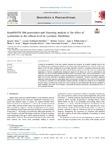ZenoSWATH DIA proteomics and clustering analysis of the effect of cysteamine at the cellular level in cystinotic fibroblasts

View/
Use this link to cite
http://hdl.handle.net/2183/40553
Except where otherwise noted, this item's license is described as Creative Commons Attribution-NonCommercial 4.0 International License (CC-BY-NC 4.0)
Collections
- Investigación (FCS) [1293]
Metadata
Show full item recordTitle
ZenoSWATH DIA proteomics and clustering analysis of the effect of cysteamine at the cellular level in cystinotic fibroblastsAuthor(s)
Date
2024-11-05Citation
Ortea I, Rodríguez-Martínez L, Carrera M, Fafián-Labora JA, Arufe MC, González-Barcia M, Fernández-Ferreiro A, Mateos J. ZenoSWATH DIA proteomics and clustering analysis of the effect of cysteamine at the cellular level in cystinotic fibroblasts. Biomed Pharmacother. 2024 Nov 5;181:117650.
Abstract
[Abstract] Cysteamine, an aminothiol, is the only available treatment for cystinosis, an incurable metabolic recessive disease characterized by detrimental symptoms at the renal, ocular, and muscular levels. Cystinosis is due to mutations in the CTNS gene encoding for the lysosomal symporter cystinosine. Cysteamine treatment only delays the symptoms, presents undesirable side effects and the patients depend on it for life. Thus, it is of paramount importance to find new complementary therapeutic targets for the disease, as well as to understand, at the molecular level, both the beneficial and detrimental effects of cysteamine. Here, we have used ZenoSWATH DIA proteomics and clustering analysis to unravel the differences between cystinotic and non-cystinotic skin fibroblasts, and to study the effect of increasing concentrations of cysteamine. Cystinotic cells present significant differences in proteins related to extracellular matrix structure and detoxification. Only a subset of those proteins is reversed by cysteamine in a dose-dependent manner, partially providing an explanation for its therapeutic benefits. Finally, cysteamine per se alters the levels of a group of lysosomal proteins that are not modulated in basal conditions. Our results will be helpful to understand the benefits, deficiencies, and detrimental effects of the cysteamine treatment.
Keywords
Clustering analysis
DIA proteomics
Lysosome
Metabolism
Rare disease
DIA proteomics
Lysosome
Metabolism
Rare disease
Editor version
Rights
Creative Commons Attribution-NonCommercial 4.0 International License (CC-BY-NC 4.0)
ISSN
0753-3322






